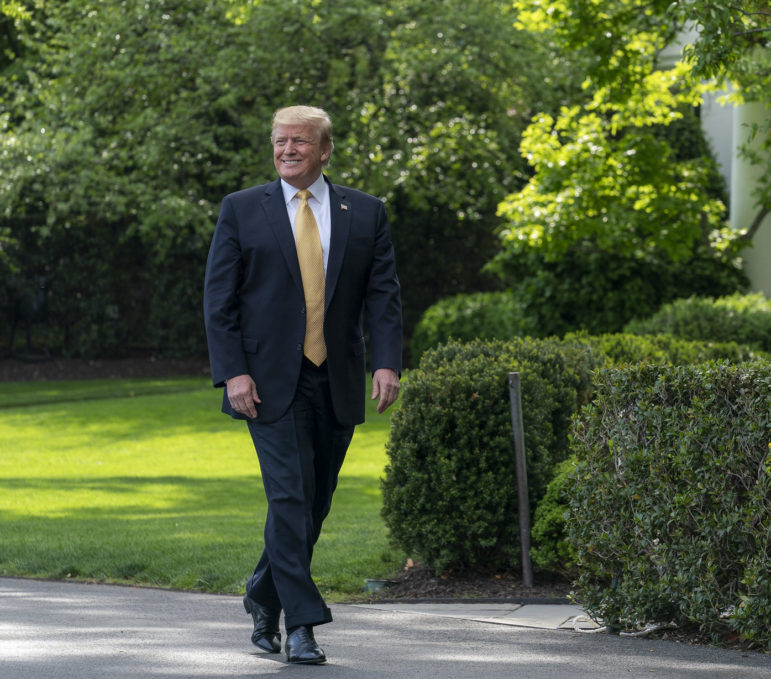
The White House
Some on the left have worried about the political wisdom of Democrats giving President Trump a huge infrastructure program. But there are policy risks as well.
In the week since President Trump and Congressional Democratic leaders announced a vague agreement to pursue a $2 trillion infrastructure plan, more than one note of doubt has been sounded. Some wondered if Trump’s commitment was likely to survive more than one news cycle. Many conservative Republicans fretted about how to pay the 13-digit price-tag. And some liberal Democrats worried that, by finding common cause with the president on infrastructure, Senate Minority Leader Chuck Schumer and House Speaker Nancy Pelosi were handing Trump a valuable victory in the midst of fallout from the Mueller report and ahead of the 2020 campaign season.
What makes infrastructure spending a political wildcard is the breadth of its appeal. Progressives adore public investments. As long as there’s a good chance much of the work will come their way, trade unions like the potential construction jobs. Business types love moves that make it easier for their employees to get to work or their product to get to market.
But the diversity of support for infrastructure spending—the sense that virtually “everyone” supports it—doesn’t mean it benefits everyone to the same degree, if at all. Depending on how the plan is structured, people in America’s rural areas (who arguably need more of an economic boost than anyone else) could be left out. And then there are those whom infrastructure spending could actually hurt: namely, low-income urban residents who could be displaced by rising housing costs resulting from the investment.
When new infrastructure creates a better connection between an area and its region, it makes operating a business there more attractive and living there more alluring. Those changes deliver benefits to existing residents and businesses in the short term, but as more affluent residents and better capitalized firms start to move in, it can price shopkeepers and residents out.
A classic case is Portland’s Interstate Corridor Urban Renewal Area Plan in 2000, which, according to the National Community Reinvestment Coalition, “catalyzed the demographic and geographic shift from historically African-American communities within Portland to the outskirts of the city.” Concerns about a similar effect have dogged plans in New York for a Brooklyn-Queens streetcar line, and were part of what scuttled a transit plan in Nashville last year. While the magnitude of displacement effects is debated, and projects could be structured to reduce those dangers, it’s clearly a risk for any major spending on roads and rails.
That displacement potential dovetails with other dangers. With an executive branch that denies the existence of a human-influenced greenhouse effect and a Republican Party that has shied from even talking about how to brace for the inevitable effects of climate change, foolish infrastructure investment could exacerbate the country’s climate vulnerabilities (not to mention increase fossil-fuel consumption if it is car-led rather than transit-centric). What’s more, the right might try to leverage the maintstream’s thirst for new infrastructure into retrograde ideological victories: According to The Hill, House Minority Leader Kevin McCarthy has suggested paying for the infrastructure plan by selling government lands.
McCarthy’s idea is a decades-old conservative obsession. But it also reveals a quirk in how the conversation about infrastructure is framed. Why are highway off-ramps and airport runways considered forms of critical infrastructure, while permanent affordable housing as well as public lands and other forms of open space are not?
As City Limits reported a couple weeks back, the question of how the U.S. uses its land—from urban parcels to farmland to open space—is increasingly urgent and affects disparate strands of our political fabric. The needs of low-income urban renters, independent farmers, families vulnerable to the worst impacts of climate change and people who recreate or work on public lands are very different. But the future for all of those households will be shaped by how the federal government weighs the public-interest value of the land it controls, regulates, influences or invests in.
Infrastructure spending without redefining that public interest and taking steps to achieve it could miss a critical opportunity. And the short-term political impact, good or bad, could be the least of its effects.









2 thoughts on “The Displacement Dangers of the Trump-Democrat Infrastructure Deal”
Pingback: Wednesday’s Headlines – Streetsblog USA
Pingback: The Driver's Side" – News From The Motorist's Perspective | theexpiredmeter.com